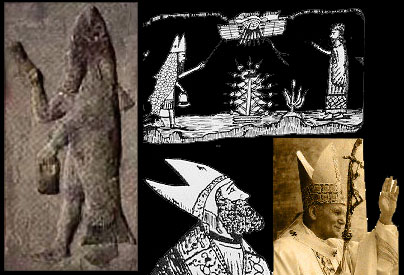The Dagon Connection
One of the mystery religions involved the Philistine idol of
the fish-man god called Dagon, which was also referred to as the devil.
The most famous temples of Dagon were at Gaza (Judges 16:21-30)
and Ashdod (1 Samuel 5:3,4; 1 Chronicles 10:10).
Dagon was represented with the face and hands of a man and the
lower half the body as the tail of a fish (1 Samuel 5:3-4).
The fish-like form was a symbol of fruitfulness, and as such was likely
to be adopted by seafaring tribes in the representation of their gods, which is why Rome who ruled the seas easilly adopted the mystery religion.
Search for pictures of the Dagon priests and you'll find they
wore fish costumes with fish head hats similar to today's miter.
The fish symbol Christians use today is literally one of the
many marks of the beast Dagon.
 Here we see carvings and diagrams of Dagon priests and their fish head hats along side
the Pope with his similar fish head hat holding the crooked cross of Mithra.
The carving on the left shows the Dagon priests sprinkling holy water.
Here we see carvings and diagrams of Dagon priests and their fish head hats along side
the Pope with his similar fish head hat holding the crooked cross of Mithra.
The carving on the left shows the Dagon priests sprinkling holy water.
 Here we see the drawing of the pagan goddess Cybele with the fish head of dagon on her head and the device used to sprinkle the holy water.
Here we see the drawing of the pagan goddess Cybele with the fish head of dagon on her head and the device used to sprinkle the holy water.
Cybele was worshipped in Rome and was called the great queen mother goddess.
Some scholars say the Basilica of Saint Peter actually stands upon the former site of Cybele's main temple.
Also there are some who say the fish head hat of the priests
of Enki (a Sumerarian god of the earth and world order)
later became the miter of the bishops.
Enki was part of the tri gods who was considered the god of
'water' and the one having devised men as slaves to the gods.
Just as the Dagon priests sprinkled holy water in ceremony,
so too did the priests of Enki- this god of water. He was even
commonly represented as a half-fish, half-goat creature.
In actuality calling Christians fish, symbolizing them
with the fish, and calling the disciples as fishers of men
has little or nothing to do with the Jesus of Capernaum.
Dagon's son was Baal the god of harvest.
The many analogies of the fish
and the mentions of harvests, wheat and tare, the seeds
along with shining sunlight and water flowing to watering it,
are all lures to converge the mystery cults in with the new
compiled religion.
In fact the tradition of eating fish on Friday
comes from many different pagan cultures.
Aphrodite Salacia, the fish Goddess, was
worshipped by her followers on her sacred day
of Friday. They ate fish and engaging in orgies.
Which is how the word "salacious" meaning lustful became used.
The Christian church assimilated this tradition by requiring the
faithful to eat fish on Friday.
Throughout the Mediterranean, mystery religions used fish,
wine and bread for their sacramental meal and ancient
Rome called Friday "dies veneris" or Day of Venus,
the Pagan goddess.
Venus is the one in the fable of the mystic egg of the Babylonians
about the giant egg falling from heaven into the River Euphrates.
The fishes rolled it to the bank where the doves having perched upon it,
hatched it. What came out of this egg was Venus-also referred to
as the morning star. Venus afterwards was called the Assyrian goddess
or Astarte, the queen of heaven.
In all of these stories we find the tradition
of Easter born from these mystery legends
as Easter was just another name for Astarte.
This festival in ancient Babylonianism of
Astarte (known as Istar or Easter), was about
her son coming back from the dead which is
why the Easter celebration has the symbolic
egg as well as the Astarte name for the celebration
of the borrowed mythical resurrection of the
Bright Morning Star -Jesus (Revelation 22:16).
Back to the Links Navigator
 Here we see carvings and diagrams of Dagon priests and their fish head hats along side
the Pope with his similar fish head hat holding the crooked cross of Mithra.
The carving on the left shows the Dagon priests sprinkling holy water.
Here we see carvings and diagrams of Dagon priests and their fish head hats along side
the Pope with his similar fish head hat holding the crooked cross of Mithra.
The carving on the left shows the Dagon priests sprinkling holy water.  Here we see the drawing of the pagan goddess Cybele with the fish head of dagon on her head and the device used to sprinkle the holy water.
Here we see the drawing of the pagan goddess Cybele with the fish head of dagon on her head and the device used to sprinkle the holy water.